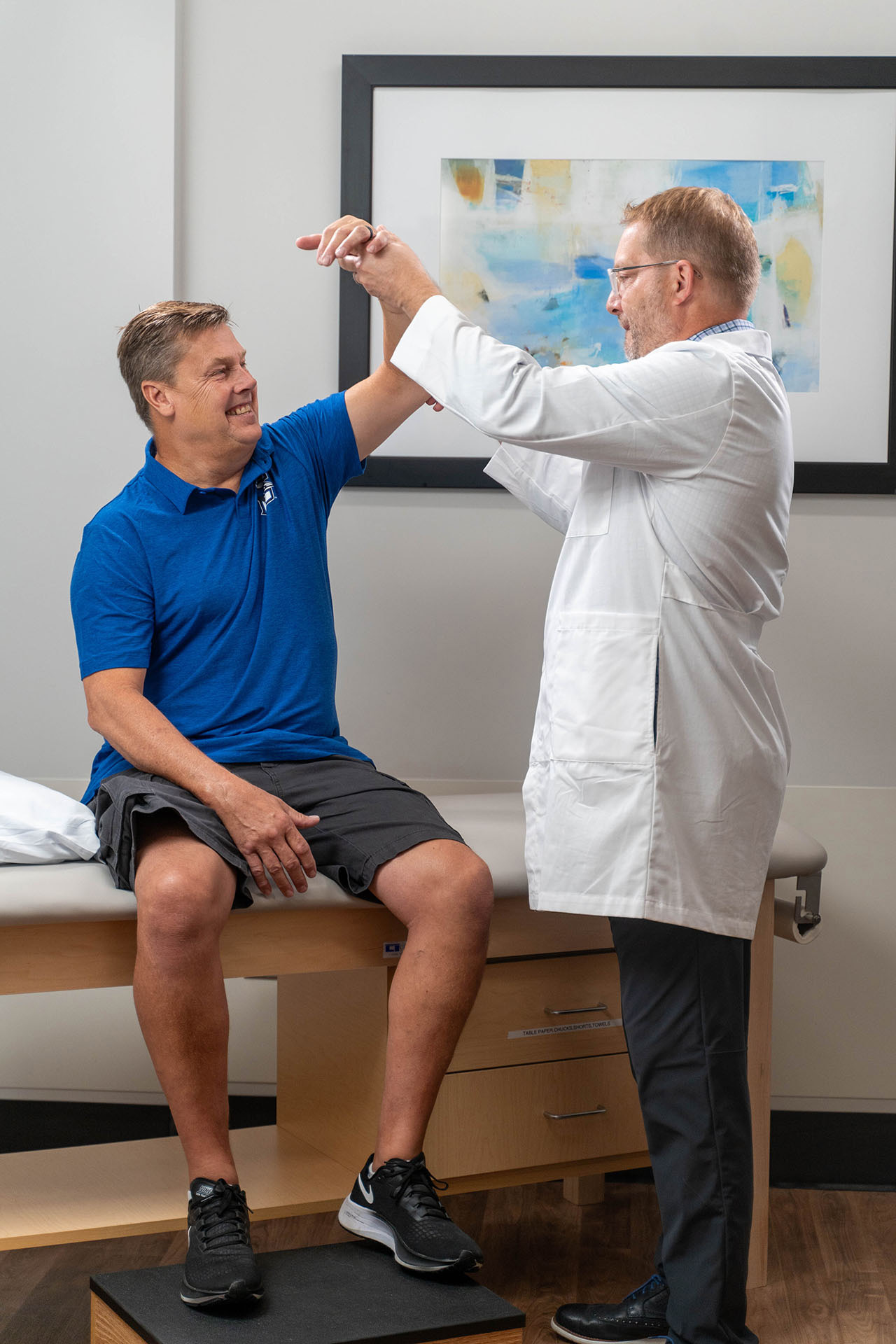Shoulder Impingement Surgery
Shoulder impingement occurs when the top outer edge of your shoulder blade, called the acromion, rubs against (“impinges on”) or pinches your rotator cuff beneath it, causing pain and irritation.

Why is my doctor recommending shoulder impingement surgery?
The Omaha Shoulder & Elbow Orthopedic Specialists at MD West ONE will determine if shoulder impingement surgery is the best course of action based on your unique situation. If you have the following symptoms, make an appointment with one of our Board Certified Shoulder Specialists.
Symptoms of shoulder impingement syndrome include:
- Pain when your arms are extended above your head.
- Pain when lifting your arm, lowering your arm from a raised position or when reaching.
- Pain and tenderness in the front of your shoulder.
- Pain that moves from the front of your shoulder to the side of your arm.
- Pain when lying on the affected side.
- Pain or achiness at night, which affects your ability to sleep.
- Pain when reaching behind your back, like reaching into a back pocket or zipping up a zipper.
- Shoulder and/or arm weakness and stiffness.
Symptoms usually develop gradually over weeks to months.
Shoulder impingement is closely related to other common sources of pain in the shoulder called bursitis and rotator cuff tendonitis. These conditions can occur alone or in combination. Shoulder pain can also be a sign of a more serious injury to your rotator cuff, a small tear or hole called a rotator cuff tear. If your rotator cuff has torn completely, you’ll likely have significant weakness and may not be able to raise your arm against gravity. In addition, you may have a rupture (tear) of your biceps muscle tendon as part of this continuing impingement process.
What is the cause?
Your rotator cuff tendon passes through a space below the acromion. The acromion is the bony tip of the outer edge of your shoulder blade (scapula) that comes off the top of the back side of this bone. It meets with the end of your collar bone (clavicle) at your shoulder. Shoulder impingement occurs when the tendon rubs against the acromion.
The causes of this impingement include:
- Your tendon is torn or swollen. This can be due to overuse from repetitive activity of the shoulder, injury or from age-related wear and tear.
- Your bursa is irritated and inflamed. Your bursa is the fluid-filled sac between your tendon and the acromion. Your bursa helps your muscles and tendons glide over your bones. Your bursa can become inflamed due to overuse of the shoulder or injury.
- Your acromion is not flat (you were born this way) or you have developed age-related bone spurs on your acromion.
Treatment
The goal of treatment for shoulder impingement syndrome is to reduce your pain and restore shoulder function. Treatments for impingement syndrome include rest, ice, over-the-counter anti-inflammatory medications, steroid injections, physical therapy and sometimes surgery.
- Physical therapy is the most important treatment for shoulder impingement syndrome. In most cases, you will only need one or two in-office visits to learn how to continue to do physical therapy on your own at home. You will learn stretching exercises to improve the range of motion of your shoulder. As your pain lessens, you can begin strengthening exercises to improve your rotator cuff muscles.
- Ice should be applied to the shoulder for 20 minutes once or twice a day. (A bag of frozen peas or corn also works well).
- If your healthcare provider approves, ibuprofen or naproxen may be taken as-needed to relieve pain. For more severe pain, a stronger prescription strength anti-inflammatory medication may be prescribe or a cortisone injection into the bursa beneath the acromion may be given.
- A common sense approach to activities is helpful. Avoid activities in which you need to frequently reach overhead or behind your back. These motions usually makes shoulders with impingement syndrome worse. Stop activities that involve these motions until your pain improves.
Shoulder Impingement Surgery
Surgery is considered if nonsurgical treatments do not relieve your pain. One surgery called a subacromial decompression or arthroscopic shoulder decompression removes part of the acromion to create more space for the rotator cuff. This procedure can be performed arthroscopically, which means through small cuts (incisions) in your shoulder. Other problems with your shoulder can be repaired at the time of surgery including arthritis in the shoulder, inflammation of the biceps tendon and partial rotator cuff tear. Open surgery, a surgery with a larger cut in the front of your shoulder, is another option.
What to Expect
If you follow your treatment plan of rest, ice, anti-inflammatory medications, physical therapy and cortisone injections, your shoulder may improvement in a few weeks or months. About 60% of people who follow these conservative therapies report satisfactory results within two years.
If your pain does not improve with nonsurgical treatments, surgery may be recommended.
Risks and Complications
Shoulder Impingement Surgery is a relatively safe procedure. Being minimally invasive it is associated with fewer risks and a quicker recovery. However, all surgeries do come with risks or potential complications. Some of the potential risks associated include:
- pain
- infection
- injury to nerves and blood vessels
- continued instability
- the need for additional surgeries

Don't wait any longer to get relief. Make an appointment to see one of our orthopedic specialists.
Meet MD West ONE's orthopedic specialists who specialize in shoulder impingement surgery.

David C. Buck, MD
Sports Medicine & Total Joint

Michael Del Core, MD
Upper Extremity Specialist

George Emodi, M.D.
Sports Medicine & Total Joint

Brett W. Fischer, MD
Sports Medicine & Total Joint

Mark Franco, M.D.
Sports Medicine & Total Joint

Daniel L. Gaffney, MD
Hand & Wrist Specialist

Kayvon Izadi, MD
Hand & Wrist Specialist

Darren Keiser, M.D.
Sports Medicine & Total Joint

John "Jack" A. McCarthy, MD
Hand & Wrist Specialist

Mark Pitner, MD
Sports Medicine & Total Joint

Charles E. Rosipal, MD
Shoulder & Elbow Specialist

Jeffrey J. Tiedeman, MD
Hand & Wrist Specialist

Kimberly A. Turman, MD
Sports Medicine
